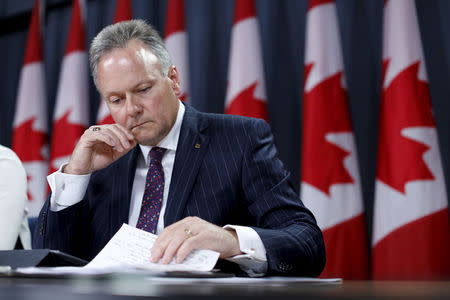Bank of Canada under fire for shift in inflation focus

By Randall Palmer OTTAWA (Reuters) - The Bank of Canada has come under fire for its increased reliance on an inflation gauge that some economists say sows confusion in financial markets and could eventually lead to monetary policy errors. The central bank, which angered many forecasters in January with a surprise rate cut and eased again this month, has a mandate to control inflation, measured by the country's consumer price index (CPI). It also uses a core-CPI measure that strips out some volatile items. Bank of Canada policymakers have put less onus in recent months on these public measures, pointing to the bank's own calculation of an "underlying trend in inflation." They say this measure, which excludes transitory factors like meat shortages and the effect of a weakening Canadian dollar, gives a clearer picture of slack in the economy. But some economists say its use effectively shifts the goal posts, making it harder to interpret how Governor Stephen Poloz will react to data and increasing the risk interest rates could stay low for too long. "If the economy was in better shape, and for whatever reason they didn't want to raise rates, what's to keep them from understating where they believe underlying inflation is?" asked Bank of Montreal senior economist Benjamin Reitzes. The Bank of Canada's is supposed to keep inflation at the midpoint of a 1 percent to 3 percent target range. While annual inflation was at just 1.0 percent in June, core-CPI was 2.3 percent and has run above the 2 percent target since August. But the bank estimated underlying inflation was 1.5 percent to 1.7 percent when it cut rates on Wednesday, and said much of the difference with core-CPI is due to currency weakness, which boosts import prices. Combined with the bank's decision to drop forward guidance, the use of an unpublished underlying trend means less transparency, said David Tulk, chief Canada macro strategist at TD Securities. "It is unorthodox to be using a measure that cannot be calculated by others," Tulk said. "Since they model the currency pass-through and other one-time effects, their underlying measure cannot be easily replicated." In response to the criticisms, the Bank of Canada said that while it targets total inflation, underlying inflation helps it understand "noise" from temporary factors. "Our use of multiple measures of inflation, which we clearly explain, helps us avoid making monetary policy errors - it doesn't increase the risk of making them," spokeswoman Louise Egan said. "This type of analysis is not new for the Bank. Our challenge has always been to look through the temporary effects and aim our policy at the movements in inflation that are persistent." CIBC World Markets Chief Economist Avery Shenfeld sees some justification for looking through the depreciation effect, but takes issue with excluding other things like meat and phone costs. "That practice could down the road have the Bank of Canada ignoring an inflation trend that wasn't as temporary," he said. TD's Tulk said the fact core inflation was above 2 percent at the time added to the surprise of the January cut and noted that other central banks tend to focus on public inflation gauges. The U.S. Federal Reserve looks mostly at core PCE (personal consumption expenditures) inflation and the Reserve Bank of Australia at two measures of underlying inflation in addition to total CPI inflation. (Editing by Jeffrey Hodgson and Lisa Shumaker)
